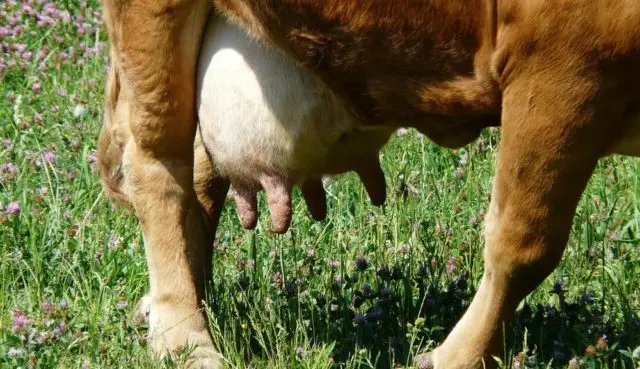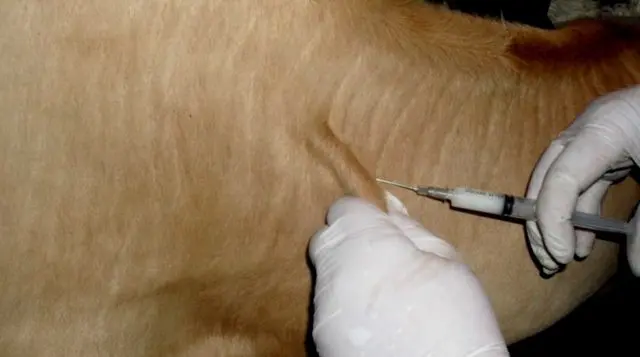Contents
Fibrinous mastitis in cows is one of the most dangerous forms of mastitis. It is characterized by inflammation of the udder and abundant formation of fibrin in the alveoli, milk ducts, and thicker tissues. Fibrinous mastitis is considered a severe pathology, as the disease develops rapidly. A complete recovery is not possible because the nodes formed at the base of the teats remain, causing discomfort to the cow and preventing the animal from returning to its previous productivity.
What is fibrinous mastitis
Mastitis is a fairly common disease that interferes with an increase in the milk production of an individual, thereby causing economic damage. In addition to reducing milk yield, mastitis contributes to premature culling of livestock, an increase in the incidence of calves, and a deterioration in product quality.

Healthy cow udder
As for fibrinous mastitis, the pathology in this form extends to a certain proportion of the udder. The disease develops very quickly, proceeds in an acute form, is characterized by a serious condition of the animal. Often takes a fibro-purulent course. Often, fibrinous mastitis gives severe complications in the form of udder gangrene or is accompanied by purulent metastases to other organs and tissues of the cow.
Causes of fibrinous mastitis in cows
Fibrinous mastitis can occur at different physiological periods in an individual – during lactation, start-up and dry period. The causes of the disease are varied: the penetration of pathogenic microflora into the animal’s digestive tract, mechanical, thermal and chemical factors.
With the penetration of microorganisms, an inflammatory process occurs in the udder as the infection multiplies (viruses, fungi, mycoplasmas). Also, the disease can provoke a hormonal failure in the animal.
The mechanical cause of mastitis is the development of infection after injury to the udder, insect bites. As a rule, this is due to inadequate care of the cow and udder.
The chemical causes of fibrotic mastitis include the improper use of veterinary drugs. In a cow, under the influence of toxins, the microflora is disturbed and this leads to a change in metabolic processes in the animal’s body.
Thermal causes of mastitis – temperature difference. For example, overheating of an individual in summer, strong cooling of the udder in winter, wind and drafts. All this negatively affects the body of the cow and the mammary glands.
However, most often fibrinous mastitis is a consequence of the catarrhal form of the disease. May also occur after purulent endometritis, traumatic cervicitis, purulent pericarditis.
Symptoms of fibrinous mastitis in cows

The initial stage of mastitis
The main symptoms of fibrinous mastitis in cows include:
- a sharp decrease in milk production or agalactia;
- the depressed state of the animal;
- increased body temperature;
- loss of appetite;
- enlargement of the supraventricular lymph node;
- increased heart rate and respiration;
- swelling of the scar, lack of chewing gum, atony of the pancreas;
- from the affected part of the udder, it is difficult to squeeze out a few drops of a cloudy liquid mixed with pus or fibrinous crumbs;
- the udder is enlarged;
- the affected quarter of the udder is edematous, hyperemic, compacted, painful on palpation, crepitus is heard.
At the same time, the cow mooes, does not allow her to touch the udder, often limps on her hind limbs, prefers to lie down, and gets up with difficulty.
Diagnosis of the disease
Methods for examining livestock for the presence of fibrinous mastitis include the following:
- measurement of body temperature, pulse rate and respiration;
- inspection of the state of the digestive tract;
- palpation of the udder, lymph nodes;
- analysis of blood, urine, milk.
Milk is diagnosed by external signs and with the help of laboratory tests. In appearance, milk from a cow with mastitis is watery, devoid of fat and heterogeneous.
You can analyze milk at home. To do this, add 1 drops of Mastidine solution to 20 mm of milk and mix. The result can be checked after 20 minutes.
Treatment of fibrinous mastitis in cows

Treatment with antibiotics
Treatment of fibrinous mastitis should be complex, since the disease affects the whole body. It is obligatory to take antibiotics, topical preparations, physiotherapy procedures (paraffin therapy). Often, traditional medicine is used as additional methods of treatment. It is necessary to change the diet of a cow with mastitis, add vitamins and trace elements, limit liquids and succulent feed.
Preventive measures
First of all, the prevention of fibrinous mastitis in cows consists in observing all the necessary sanitary, hygienic standards for the care and maintenance of animals. Important is the correct processing of the cow’s udder before and after the milking procedure, as well as the correct technique, massage of the mammary gland. In addition, the diet is important in accordance with the physiological state of the animal, as well as vitamin supplements and minerals.
Conclusion
Fibrinous mastitis in cows is a complex disease of the udder of an animal that develops rapidly and can have unpleasant consequences. An undeveloped disease responds well to treatment, however, if the disease has taken a chronic course or complications have arisen, then the prognosis is unfavorable. The development of fibrous mastitis is easy to avoid by properly caring for the individual and making a competent feeding ration.









